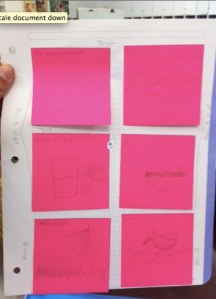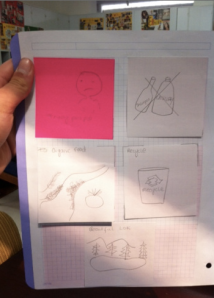1″Literacy is More Than Books and Pens” Article:
1. The main point of this article is saying that some less-traditional ways of learning, such as using technology and groups, are better for learning than simply writing and reading things. It also says that this type of learning will then encourage some self- teaching, so that the student will not need the teacher at all times and instead solve situations by him-herself, and achieve deeper levels of analyzing.
2. “Research on ways people learn and demonstrate knowledge shows that both are as diverse as the physiques of our students.”
“Educators are learning through experience, from news broadcasts, and from research that young people have multiple intelligences and that students must acquire critical thinking skills to become effective communicators”.
“Consequently, because we know that humans learn in a variety of modalities, we teachers must incorporate more diverse strategies in our instruction and offer students an array of ways to demonstrate their levels of understanding of literature and of life.”
Digital Story Elements:
- A point of view: The opinion part of the story, the part trying to make an argument or point.
- A dramatic question: To catch the audiences attention, it should be stated at the begining and end.
- Pathos: The part of your argument that touches peoples feelings.
- Voice: The tone of your video.
- The Soundtrack: Music or special effects.
- Brief, Compact Fast-moving.
- Pacing, Rhythm, Tempo Rate, Speed, Interest
Class Work (video 2)
1. To portray Golfo de Morrosquillo as a fun trip for students, teachers, and parents.
2. Text: They put the name of each place and the acitvities so they would know whats going on in the pictures. The pictures were organized by activity so it made it easier to understand, while being brief so that you didnt get bored.
Images: The pictures were bright, colorful, and cheerful. The kids were smiling and engaging in all the activities. You could also tell there was beautiful scenery and a warm climate.
Sound: Music that was appropiete for the place, always upbeat and happy. in the sombrero vueltiao there was a song in spanish, in sanguare there was a tropical song about islands, in the mangroves there was a song about the sun, etc. Overall they all fit the “fun beach” theme, which sets the mood for the trip.
3. The “voice” of the video is very relaxed, exited for all the activities. It really has no point beyond stating that the trip is fun, so its basically just the songs setting a cheerful mood. There are also a couple interviews, and the kids in them sound like they’re having a good time.
10 things:
The main purpose of our video is to tell people just how much water is polluted and how much water we use every day, so they can understand that unless we take care of it, we will run out.
Sounds:
Clapping
Tapping
Wind
Waves
Trees moving
Birds
Seashells
Rain
Under the Sea: Little Mermaid song
Katrina & The Waves – Walking On Sunshine
Images:
How we use it:
-a picture of pretty beach/ lake/ river
-people drinking water
-food
-a picture of a pool
How we pollute it:
– a beach full of garbage
-a fish with water
-animals with water contaminated
-dirty water
How much is left?
-a graph showing how much water is clean
-a glacier
-thirsty people
Facts:
-Pollution of freshwater (drinking water) is a problem for about half of the world’s population. Each year there are about 250 million cases of water-related diseases, with roughly 5 to 10 million deaths
-Diseases caused by the ingestion of water contaminated with pathogenic bacteria, viruses, or parasites include:
cholera
typhoid
schistosomiasis
dysentery and other diarrheal diseases
-Each year, plastic waste in water and coastal areas kills up to:
100,000 marine mammals,
1 million sea birds, and
countless fish.
– Caribean ocean is most affected by suspended solids and oil spills
-Around 80% of the pollution in seas and oceans comes from land-based activities
-Small amounts of contaminants from all over the land add up to cause pollution in our water.
-Oil and antifreeze from leaking cars pollutes. When it rains, water runs over the ground and picks up oil, antifreeze, and other pollutants and carries them to our streams and bays.
-Household cleaners and chemicals can pollute. Cleaners and chemicals used or disposed of outside can end up in our streams and bays. These same cleaners and chemicals can cause harm to septic systems and wastewater treatment plants.
-Waste from livestock pollutes our water. When it rains, water runs over fields and pastures and can carry harmful bacteria from livestock waste to streams and provides unwanted fertilizer in streams.
-Lawn clippings and yard waste in ravines and ponds can become unwanted fertilizer for streams. Too much plant growth in streams can use up all the oxygen and kill fish and aquatic life.
Script:
Scene 1: clean ocean in the scene with the sound of the waves
Scene 2: the San Jorge rive the the current sounding. “The future belongs to us, because we have taken charge of it. We have the commitment, we have the resourcefulness, and we have the strength of our people to share the dream across the world of clean water for all.
Scene 3: Water pollution occurs when pollutants go directly or indirectly into the water without the required treatment that cleans it.
Scene 4: Water is life’s mater and matrix, mother and medium. There is no life without water.
Scene 9-10-11: Here comes the sun: The Beatles
StoryBoard:
It didn’t let me upload the pictures, but I did it with Gabriela Copello. The pictures are in her blog http://www.britishsummers.wordpress.com
Our Video:

